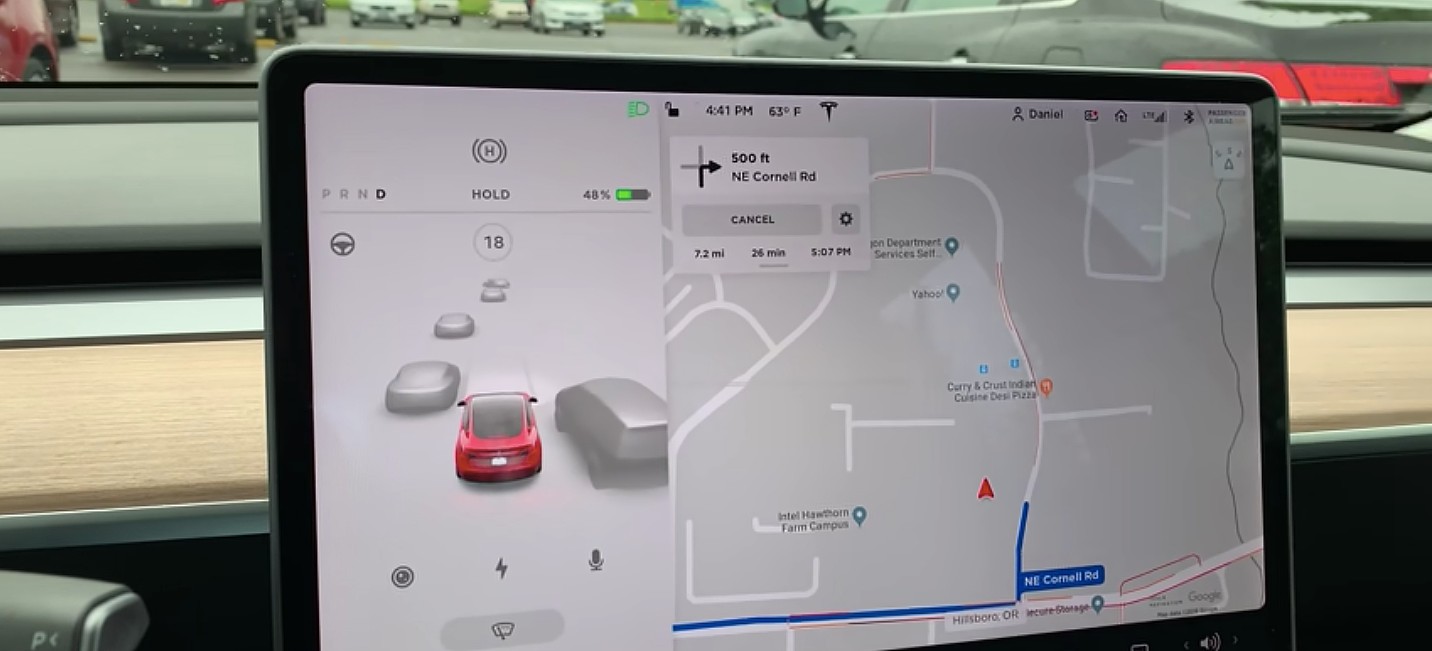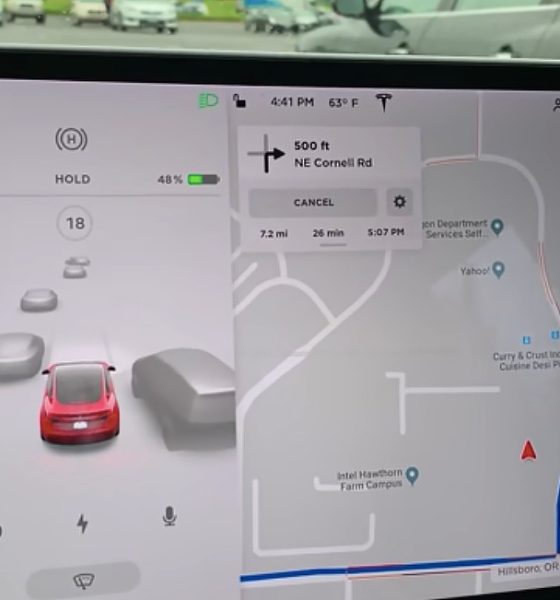

News
Tesla’s Driving Visualization will soon depict the company’s vehicles
Tesla’s Driving Visualization feature will soon render each of the company’s electric vehicles accurately, instead of using the generic sedan, SUV, or pickup that appears on the Dashscreen currently. Company CEO Elon Musk confirmed that Driving Visualization would receive these improvements, which could open the door for a new in-car video game.
Musk responded to a question from a Twitter follower that asked if Driving Visualization would improve to have custom vehicle models on the dash screen display. @WholeMarsBlog‘s focus was primarily on the Visualization of the Tesla Cybertruck. “Rendering as a normal truck seems inappropriate,” the question said.
However, Musk confirmed that not only the Cybertruck would be rendered accurately, but all Tesla vehicles would render “specifically as their model & color instead of as a generic sedan/SUV.”
Yeah. Display will also soon render Teslas specifically as their model & color instead of as a generic sedan/SUV. Has potential for a fun punch buggy sort of game.
— Elon Musk (@elonmusk) July 30, 2020
Driving Visualization gives Tesla owners a full-range animated image of the surroundings of the car. This includes other vehicles and some objects on the road.
However, the feature does not tell the driver precisely what vehicle is surrounding their car. It generalizes its surroundings by showing only the type of vehicle. For example, if a Ford Escape were near the Tesla, an SUV would appear, but its shape would not match the exact look of a Ford Escape.
Interestingly enough, the Driving Visualization feature does not depict other Tesla cars. But it seems an update will arrive soon for owners that will fix this.
Additionally, Musk hinted that a new “punch buggy sort of game” could be derived from the next improvements to Driving Visualization.
Tesla has worked to continuously improve the gamification within its vehicles, which has been a focus of Musk. The Tesla CEO himself is an avid video game fan, and he has made it a point to add video games and other sources of entertainment into its vehicles to keep drivers occupied when using a Supercharger or during downtime.
During the company’s recent Q2 2020 Earnings Call, Musk indicated that Tesla is working to add more features related to productivity and entertainment to prepare for the company’s Full Self-Driving suite is complete and autonomous driving is possible.
“Now, when things do become full self-driving, so what are people going to do in the car,” Musk asked. “Well, I guess they’re probably going to do productivity and entertainment of some kind, watch movies, play games, and do work. That’s in the future. We’re already putting some games and stuff on the car just for fun.”
Currently, the company does offer a buggy-styled racing game with Beach Buggy Racing 2. The game can be played with the use of the steering wheel, or by plugging in a compatible gaming controller.
Improvements to Tesla’s Driving Visualization will not only increase the accuracy of the company’s Autopilot and FSD suites, but it will also give owners an additional sense of pride when driving near another one of the company’s electric cars. Also, the addition of a new video game within the vehicle will increase entertainment for drivers while there is downtime.

News
Tesla starts showing how FSD will change lives in Europe
Local officials tested the system on narrow country roads and were impressed by FSD’s smooth, human-like driving, with some calling the service a game-changer for everyday life in areas that are far from urban centers.

Tesla has launched Europe’s first public shuttle service using Full Self-Driving (Supervised) in the rural Eifelkreis Bitburg-Prüm region of Germany, demonstrating how the technology can restore independence and mobility for people who struggle with limited transport options.
Local officials tested the system on narrow country roads and were impressed by FSD’s smooth, human-like driving, with some calling the service a game-changer for everyday life in areas that are far from urban centers.
Officials see real impact on rural residents
Arzfeld Mayor Johannes Kuhl and District Administrator Andreas Kruppert personally tested the Tesla shuttle service. This allowed them to see just how well FSD navigated winding lanes and rural roads confidently. Kruppert said, “Autonomous driving sounds like science fiction to many, but we simply see here that it works totally well in rural regions too.” Kuhl, for his part, also noted that FSD “feels like a very experienced driver.”
The pilot complements the area’s “Citizen Bus” program, which provides on-demand rides for elderly residents who can no longer drive themselves. Tesla Europe shared a video of a demonstration of the service, highlighting how FSD gives people their freedom back, even in places where public transport is not as prevalent.
What the Ministry for Economic Affairs and Transport says
Rhineland-Palatinate’s Minister Daniela Schmitt supported the project, praising the collaboration that made this “first of its kind in Europe” possible. As per the ministry, the rural rollout for the service shows FSD’s potential beyond major cities, and it delivers tangible benefits like grocery runs, doctor visits, and social connections for isolated residents.
“Reliable and flexible mobility is especially vital in rural areas. With the launch of a shuttle service using self-driving vehicles (FSD supervised) by Tesla in the Eifelkreis Bitburg-Prüm, an innovative pilot project is now getting underway that complements local community bus services. It is the first project of its kind in Europe.
“The result is a real gain for rural mobility: greater accessibility, more flexibility and tangible benefits for everyday life. A strong signal for innovation, cooperation and future-oriented mobility beyond urban centers,” the ministry wrote in a LinkedIn post.
News
Tesla China quietly posts Robotaxi-related job listing
Tesla China is currently seeking a Low Voltage Electrical Engineer to work on circuit board design for the company’s autonomous vehicles.

Tesla has posted a new job listing in Shanghai explicitly tied to its Robotaxi program, fueling speculation that the company is preparing to launch its dedicated autonomous ride-hailing service in China.
As noted in the listing, Tesla China is currently seeking a Low Voltage Electrical Engineer to work on circuit board design for the company’s autonomous vehicles.
Robotaxi-specific role
The listing, which was shared on social media platform X by industry watcher @tslaming, suggested that Tesla China is looking to fill the role urgently. The job listing itself specifically mentions that the person hired for the role will be working on the Low Voltage Hardware team, which would design the circuit boards that would serve as the nervous system of the Robotaxi.
Key tasks for the role, as indicated in the job listing, include collaboration with PCB layout, firmware, mechanical, program management, and validation teams, among other responsibilities. The role is based in Shanghai.
China Robotaxi launch
China represents a massive potential market for robotaxis, with its dense urban centers and supportive policies in select cities. Tesla has limited permission to roll out FSD in the country, though despite this, its vehicles have been hailed as among the best in the market when it comes to autonomous features. So far, at least, it appears that China supports Tesla’s FSD and Robotaxi rollout.
This was hinted at in November, when Tesla brought the Cybercab to the 8th China International Import Expo (CIIE) in Shanghai, marking the first time that the autonomous two-seater was brought to the Asia-Pacific region. The vehicle, despite not having a release date in China, received a significant amount of interest among the event’s attendees.
Elon Musk
Elon Musk and Tesla AI Director share insights after empty driver seat Robotaxi rides
The executives’ unoccupied tests hint at the rapid progress of Tesla’s unsupervised Robotaxi efforts.

Tesla CEO Elon Musk and AI Director Ashok Elluswamy celebrated Christmas Eve by sharing personal experiences with Robotaxi vehicles that had no safety monitor or occupant in the driver’s seat. Musk described the system’s “perfect driving” around Austin, while Elluswamy posted video from the back seat, calling it “an amazing experience.”
The executives’ unoccupied tests hint at the rapid progress of Tesla’s unsupervised Robotaxi efforts.
Elon and Ashok’s firsthand Robotaxi insights
Prior to Musk and the Tesla AI Director’s posts, sightings of unmanned Teslas navigating public roads were widely shared on social media. One such vehicle was spotted in Austin, Texas, which Elon Musk acknowleged by stating that “Testing is underway with no occupants in the car.”
Based on his Christmas Eve post, Musk seemed to have tested an unmanned Tesla himself. “A Tesla with no safety monitor in the car and me sitting in the passenger seat took me all around Austin on Sunday with perfect driving,” Musk wrote in his post.
Elluswamy responded with a 2-minute video showing himself in the rear of an unmanned Tesla. The video featured the vehicle’s empty front seats, as well as its smooth handling through real-world traffic. He captioned his video with the words, “It’s an amazing experience!”
Towards Unsupervised operations
During an xAI Hackathon earlier this month, Elon Musk mentioned that Tesla owed be removing Safety Monitors from its Robotaxis in Austin in just three weeks. “Unsupervised is pretty much solved at this point. So there will be Tesla Robotaxis operating in Austin with no one in them. Not even anyone in the passenger seat in about three weeks,” he said. Musk echoed similar estimates at the 2025 Annual Shareholder Meeting and the Q3 2025 earnings call.
Considering the insights that were posted Musk and Elluswamy, it does appear that Tesla is working hard towards operating its Robotaxis with no safety monitors. This is quite impressive considering that the service was launched just earlier this year.








